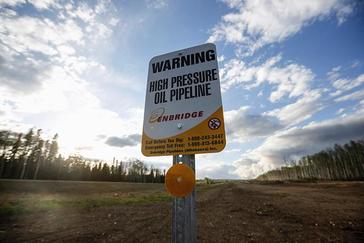 In 2014, Board members of the Pine River Watershed Alliance were presented with a proposal for the Enbridge Sandpiper pipeline route through their watershed. The proposed pipeline was to carry oil from the Alberta tar sands oilfields, and it was proposed to go UNDER the Pine River. What does this mean for the river, and the lakes that it flows through? In 2016, the Sandpiper pipeline was cancelled, but a new pipeline project – called Line 3 Replacement – was proposed to follow the same route. The Line 3 replacement project—from Joliette, N.D., to Superior, Wis.—stretches 364 miles in the U.S. and would involve a pipe 36 inches in diameter to be built pending regulatory approval. This 36” pipeline would cross four streams that contribute water to the Whitefish Chain of Lakes – the jewel of the Pine River Watershed. Members of the Pine River Watershed Alliance were concerned, and eventually took a position that supported the need for energy but demanded that the environment be protected. On the PRWA’s website, in a statement dated October 2017, their chair Ron Meyer said, “Activity on Enbridge Line 3 continues. There has been a lot of local TV and radio commercials supporting the construction of Line 3. The ads are not totally accurate. The MN Department of Commerce recently issued a report that states there is much more pipeline capacity than presently needed. MN does get 100,000 barrels of gasoline from the Superior refiner and maintaining that will not be affected by Line 3. PRWA is not against pipelines but we don’t want a pipeline through our critical water sources…” This very local controversy highlights the concerns with this project. The Minnesota Public Utilities Commission (PUC) will be deciding whether to issue a certificate of need and a pipeline routing permit for this project; the comment period for this project is now open and evidentiary hearings will take place in November. Public hearings around the area have aroused much interest on both sides of the issue, both pro- and against- the pipeline. The proposed route crosses the Mississippi near the Headwaters as well as many tributaries to the Upper Mississippi along the way. It will carry all grades of crude oil from Canada to the Enbridge terminal in Superior, Wisconsin. The PUC website features an interactive map showing the current Line 3 route as well as the proposed route for the upgraded pipeline. The proposed new pipeline would use the power of eminent domain to potentially transport 760,000 barrels of Canadian tar sands oil per day. When the UMRR Board met at the Headwaters on October 2, we experienced the beauty of the area and walked across the River at its beginning. We also met folks from the Friends of the Headwaters, a local citizen's group organized to address the planned pipeline. According to their website, they are organized “for the purpose of protecting our precious resources: Itasca State Park, the Mississippi River, our clean lakes and trout streams, the aquifer for our drinking water, our forests and wildlife from the potentially devastating impacts that will occur if the Enbridge Line 3 pipeline is constructed on the currently proposed route in Hubbard, Clearwater, Cass, Aitkin and Carlton Counties.” So, what are the facts? Is this pipeline necessary? The Minnesota Department of Commerce looked at that question, and they found that “in light of the serious risks and effects on the natural and socioeconomic environments of the existing Line 3 and the limited benefit that the existing Line 3 provides to Minnesota refineries, it is reasonable to conclude that Minnesota would be better off if Enbridge proposed to cease operations of the existing Line 3, without any new pipeline being built.” (Quote from Ron Meador/MinnPost.) The Minnesota Environmental Partnership (an organization of which LWV MN is a member) provided an interesting analysis on their website. This factsheet, with references, provides a more in-depth look at the issue. Because the pipeline would pass through significant wild rice resources, the proposed pipeline is of great concern to Native American groups as well – Winona La Duke is a spokesperson for the group Honor the Earth which has been protesting at events around the region. To counter these efforts, Enbridge has been promoting the project through commercials on Minnesota television and their website. This will all come to a head in April, when the Minnesota Public Utilities Commission decides on the certificate of need and route permit. Stand by for the rest of the story!
0 Comments
Leave a Reply. |
| LWV Upper Mississippi River Region | UMRR blog |

 RSS Feed
RSS Feed